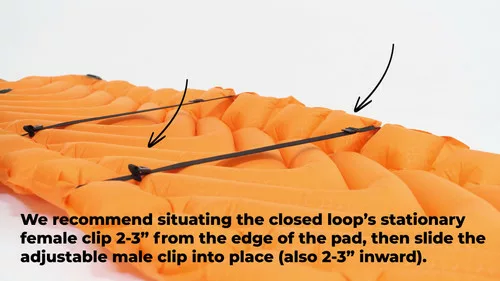So you’ve got a camping trip coming up and you want to make the most of your backpack space. Well, look no further because we’ve got the ultimate guide on attaching a sleeping pad to your backpack. Whether you’re a seasoned camper or a newbie, this article will walk you through the step-by-step process of securely fastening your sleeping pad to your backpack, ensuring a comfortable and convenient journey in the wilderness. Say goodbye to carrying extra bulky gear and hello to a more streamlined backpacking experience!
Understanding the Importance of a Sleeping Pad
Sleeping pads play a crucial role in ensuring a comfortable and restful night’s sleep while camping or backpacking. They provide insulation from the cold ground, cushioning for your body, and help distribute your weight evenly, preventing any pressure points. Without a proper sleeping pad, you might wake up feeling sore, uncomfortable, and tired, which can negatively impact your overall camping experience. Therefore, it is essential to understand the importance of a sleeping pad and choose the right one for your needs.
The Role of a Sleeping Pad
A sleeping pad acts as a barrier between you and the ground, providing insulation and warmth. The ground can absorb and conduct heat from your body, leading to discomfort and restless sleep, especially in colder climates. A sleeping pad minimizes heat loss, keeping you warm throughout the night. Additionally, sleeping pads also provide cushioning, making it more comfortable to lie down and rest after a long day of hiking or outdoor activities.
Various Types of Sleeping Pads
There are several types of sleeping pads available on the market, each with its unique features and benefits. The most common types include foam pads, inflatable pads, and self-inflating pads. Foam pads are usually lightweight and provide excellent insulation but may lack cushioning. Inflatable pads are more comfortable and adjustable, as they can be inflated to the desired firmness. Self-inflating pads combine the convenience of foam pads with the comfort of inflatable pads, as they self-inflate when the valve is opened, eliminating the need for manual inflation.
Key Features to Look for in a Sleeping Pad
When choosing a sleeping pad, there are a few key features to consider. First, consider the pad’s insulation value, often denoted by the R-value. This value determines how well the pad insulates you from the ground, with higher values indicating better insulation. Next, consider the pad’s thickness and cushioning. Thicker pads generally provide more comfort, but they may also be bulkier and heavier. Finally, consider the pad’s size and weight, ensuring it fits well in your backpack and is suitable for your intended outdoor activities.
Why Attach a Sleeping Pad to Your Backpack
Attaching a sleeping pad to your backpack offers several advantages, making it a practical and efficient choice for outdoor enthusiasts. Let’s explore the reasons why you should consider attaching your sleeping pad to your backpack.
Saving Space Inside the Backpack
One of the primary benefits of attaching a sleeping pad to your backpack is the saved space inside. By securely strapping your sleeping pad to the exterior of your backpack, you free up valuable internal space for other essential items, such as clothes, food, and camping gear. This external attachment ensures that you can pack efficiently and carry everything you need without compromising on comfort or necessities.
Quick Access and Ease of Use
Attaching your sleeping pad to your backpack provides quick and easy access when you need to set up your sleeping area. Instead of rummaging through your backpack to find your sleeping pad, you can simply detach it from the exterior attachment points and have it ready in no time. This convenience is especially handy when you arrive at the campsite late or are setting up in adverse weather conditions.
Protection and Insulation of Other Items
Attaching a sleeping pad to the outside of your backpack not only saves space but also provides protection and insulation for other items inside the bag. The padding from the sleeping pad acts as a cushion, preventing any external impact from damaging fragile items. Additionally, when camping in colder environments, strapping the sleeping pad to the outside of the backpack can provide an extra layer of insulation, keeping the contents of your bag from getting too cold or freezing.
Before Attaching: Preparing Both Backpack and Sleeping Pad
Before you begin attaching your sleeping pad to your backpack, it is crucial to prepare both items properly. This preparation ensures that your sleeping pad is in good condition and compatible with your backpack, guaranteeing a secure attachment and optimal performance during your outdoor adventures.

Checking the Condition of the Sleeping Pad
Inspect your sleeping pad for any signs of damage or wear. Look for punctures, leaks, or tears that could compromise its functionality. If you notice any issues, repair or replace the sleeping pad accordingly. Additionally, check the valves and ensure they are in good working condition, so your pad can inflate properly if it is an inflatable or self-inflating type.
Ensuring the Appropriateness of the Backpack
Check your backpack to ensure it has appropriate attachment points or loops for securing a sleeping pad. The backpack should have external straps, buckles, or loops that can accommodate the size and width of your sleeping pad. If your backpack lacks these attachment options, explore alternative methods, such as bungee cords or utilizing the backpack’s daisy chain, which we will cover in later sections.
Cleaning and Drying Both Items
Before attaching your sleeping pad to your backpack, make sure both items are clean and dry. Remove any dirt, dust, or debris from your sleeping pad using a gentle brush or damp cloth. Allow the pad to air dry completely before proceeding. Similarly, clean your backpack’s exterior surface, paying attention to the attachment points, and ensure it is dry as well. This step ensures a hygienic attachment and prevents any moisture-related problems during your outdoor adventure.
Methods to Attach a Sleeping Pad
There are several methods to attach a sleeping pad to your backpack, depending on the design and features of both the pad and the backpack. Here, we will explore four common methods: using straps and buckles, using bungee cords, using external loops of the backpack, and utilizing the backpack’s daisy chain.
Using Straps and Buckles
Attaching a sleeping pad using straps and buckles is a versatile and secure method. This method works best with backpacks that come with integrated straps and buckles or when using a separate accessory like a sleeping pad strap. To attach the sleeping pad, secure the straps around the pad, threading them through the loops or attachment points on your backpack. Adjust the tension as needed, ensuring a tight and secure fit.
Using Bungee Cords
Bungee cords offer a flexible and adjustable solution for attaching a sleeping pad to your backpack. Begin by attaching the bungee cords to the attachment points on your backpack, preferably using the existing loops or grommets. Then, stretch the bungee cords over your sleeping pad, securing it tightly against the backpack’s exterior. The elastic nature of the bungee cords allows for easy attachment and detachment, making this method convenient for quick setup and breakdown.
Using External Loops of the Backpack
Many backpacks feature external loops or compression straps that can be utilized to attach your sleeping pad securely. Start by passing the loops of the pad through these external loops or straps, ensuring a tight and stable attachment. Adjust the straps as necessary to prevent any excessive movement or shifting of the sleeping pad during your outdoor activities. This method is straightforward and works well with backpacks that have conveniently placed external attachment options.

Utilizing Backpack’s Daisy Chain
Some backpacks come equipped with a daisy chain, which is a series of small loops or webbing stitched onto the pack’s exterior. These loops provide multiple attachment points for securing various items, including a sleeping pad. Slide the sleeping pad through the loops of the daisy chain, weaving it back and forth for a secure fit. Adjust the tension and placement of the pad to ensure it is centered and balanced within the daisy chain. This method offers versatility and customization, allowing you to adjust the attachment to your preference.
Step by Step Procedure: Using Straps and Buckles
Materials Needed
- Backpack with integrated straps and buckles or a separate sleeping pad strap
- Sleeping pad
Detailed Step-by-Step Instructions
- Begin by fitting the straps or the sleeping pad strap around the sleeping pad, making sure it is centered.
- Look for attachment points on the exterior surface of your backpack. These may be integrated straps and buckles or dedicated loops for attaching a sleeping pad.
- Thread the straps or the looped ends of the sleeping pad strap through the attachment points on your backpack.
- Adjust the straps or the sleeping pad strap to achieve the desired tension. Pull both ends of the straps simultaneously, ensuring the sleeping pad is securely attached and does not move excessively.
- Double-check the attachment to make sure it is tight and stable. Give the sleeping pad a gentle tug to test its stability.
Safety Precautions and Tips
- Make sure the sleeping pad is positioned securely and does not block your range of motion or interfere with the backpack’s functionality.
- When adjusting the tension of the straps or sleeping pad strap, be careful not to overtighten and potentially damage the sleeping pad or the backpack.
- If your backpack does not have integrated straps or buckles, consider using a separate sleeping pad strap specifically designed for attaching sleeping pads to backpacks.
Step by Step Procedure: Using Bungee Cords
Materials Needed
- Backpack with attachment loops or grommets
- Bungee cords
- Sleeping pad
Detailed Step-by-Step Instructions
- Begin by attaching one end of the bungee cord to an attachment loop or grommet on your backpack.
- Stretch the bungee cord over the sleeping pad, ensuring it covers the entire width of the pad.
- Attach the other end of the bungee cord to the corresponding attachment loop or grommet on the opposite side of the backpack.
- Adjust the tension of the bungee cord, ensuring it is tight enough to securely hold the sleeping pad against the backpack’s exterior but not too tight that it causes discomfort or strain.
- Test the stability of the attachment by giving the sleeping pad a gentle tug to check if it remains firmly in place.

Safety Precautions and Tips
- Be cautious when adjusting the tension of the bungee cords, as excessive pulling force could damage the sleeping pad or the backpack’s attachment points.
- Regularly check the bungee cords for any signs of wear or fraying, and replace them if necessary.
- Consider using cord locks or toggle stops to secure the bungee cords in place and prevent them from slipping or loosening during your outdoor activities.
Step by Step Procedure: Using External Loops of the Backpack
Materials Needed
- Backpack with external loops or compression straps
- Sleeping pad
Detailed Step-by-Step Instructions
- Locate the external loops or compression straps on your backpack that can be used to attach the sleeping pad.
- Slide one end of the sleeping pad through one of the loops or compression straps, starting from the bottom.
- Continue weaving the sleeping pad back and forth through the loops or compression straps until you reach the opposite side of the backpack.
- Adjust the tension of the loops or compression straps as needed to ensure the sleeping pad is tightly secured against the backpack’s exterior.
- Test the attachment by gently shaking or moving the backpack to ensure that the sleeping pad remains stable and does not shift or slide.
Safety Precautions and Tips
- Make sure the sleeping pad is woven securely through the loops or compression straps to prevent it from becoming loose or dislodged.
- Avoid attaching the sleeping pad too high or too low on the backpack, as this can affect the overall balance and comfort when carrying the bag.
- Trim any excess strap length to minimize the risk of tangling or snagging during your outdoor activities.
Step by Step Procedure: Utilizing Backpack’s Daisy Chain
Materials Needed
- Backpack with a daisy chain
- Sleeping pad
Detailed Step-by-Step Instructions
- Locate the daisy chain on your backpack, which consists of multiple loops or webbing stitched onto the pack’s exterior.
- Begin sliding one end of the sleeping pad through the first loop of the daisy chain, ensuring it is centered and balanced.
- Weave the sleeping pad back and forth through the loops of the daisy chain, gradually progressing from one end to the other.
- Adjust the placement of the sleeping pad within the daisy chain to achieve the desired position and tension. The pad should be centered and securely attached without any excessive movement.
- Once the sleeping pad is attached, verify that the attachment is snug and stable by giving the pad a gentle shake or tug.
Safety Precautions and Tips
- Be mindful of the weight distribution when attaching the sleeping pad to the daisy chain. Keep the pad positioned towards the center of the backpack to maintain the overall balance and stability.
- Avoid overloading the daisy chain with too much weight, as it may compromise the backpack’s structural integrity or cause discomfort during extended periods of wear.
- If your backpack does not have a daisy chain, consider alternative methods such as straps and buckles or bungee cords to securely attach your sleeping pad.
Post-Attachment: Ensuring Optimal Balance and Comfort
Once you have attached your sleeping pad to your backpack, it is essential to ensure optimal balance and comfort before embarking on your outdoor adventure. Here are a few steps to follow:
Checking the Balance
Take a moment to evaluate the balance of your backpack with the attached sleeping pad. Shift the weight slightly from side to side to ensure that the load is evenly distributed. If you notice any significant imbalances or discomfort, make necessary adjustments to the sleeping pad’s position or attachment method.
Verifying the Security of the Attachment
Confirm that the sleeping pad is securely attached to your backpack. Give the pad a slight tug or shake to ensure it does not move excessively or come loose. Double-check the straps, buckles, bungee cords, or attachment points to ensure they are properly tightened and fastened. A secure attachment will prevent the sleeping pad from shifting or falling off during your outdoor activities.
Inspecting for Any Discomfort During Movement
Put your backpack on and move around to simulate the motions you will encounter during your upcoming adventure. Pay attention to any discomfort or movement caused by the attached sleeping pad. Ensure that the pad does not hinder your range of motion or cause rubbing or chafing against your body. If you experience any discomfort, readjust the pad’s position or attachment method until you achieve a comfortable fit.
Maintaining Your Backpack and Sleeping Pad
Proper maintenance of your backpack and sleeping pad is essential to ensure their longevity and optimal performance. Follow these tips to keep your gear in excellent condition for future adventures.
Regular Cleaning and Drying
After each outdoor trip, take the time to clean your backpack and sleeping pad. Remove any dirt, debris, or stains using mild soap, warm water, and a soft brush or cloth. Pay close attention to the attachment points or straps, ensuring they are free from any dirt or grime. Once cleaned, allow both the backpack and sleeping pad to air dry completely before storing them.
Proper Storage Practices
Store your backpack and sleeping pad in a cool, dry place away from direct sunlight or extreme temperatures. Avoid folding or compressing your pad for extended periods, as this can damage the insulation or valves. Instead, roll or fold the pad loosely and store it in a breathable stuff sack or bag. Similarly, store your backpack in an upright position to maintain its shape and prevent any distortion or deformation.
Regular Inspection for Any Damage or Wear
Periodically inspect your backpack and sleeping pad for any signs of damage or wear. Check the seams, zippers, straps, and attachment points for any fraying, tears, or loose stitching. If you notice any issues, repair or replace the affected parts promptly. Regular inspections allow you to address minor problems before they escalate, ensuring the longevity and reliability of your gear.
By properly maintaining and caring for your backpack and sleeping pad, you can continue to enjoy comfortable nights’ sleep and hassle-free outdoor adventures for years to come.
In conclusion, attaching a sleeping pad to your backpack offers numerous benefits, ranging from saving internal space to providing quick access and protection for your gear. By following the outlined methods, step-by-step procedures, and maintenance practices, you can securely attach your sleeping pad, ensuring optimal balance, comfort, and enhanced camping experiences. Remember to always choose a suitable sleeping pad type and size, consider the attachment options of your backpack, and prioritize safety and convenience when attaching and using your gear for outdoor expeditions.
